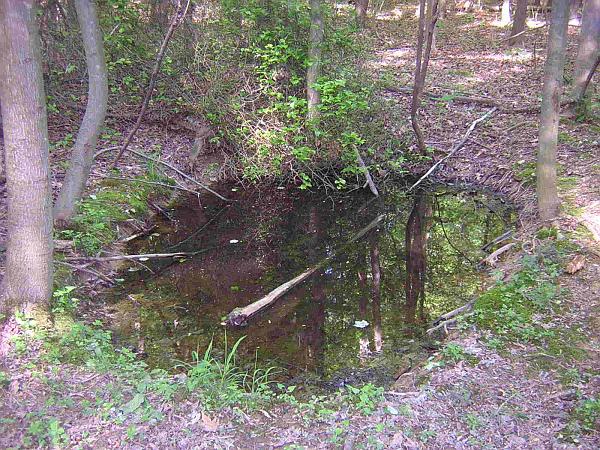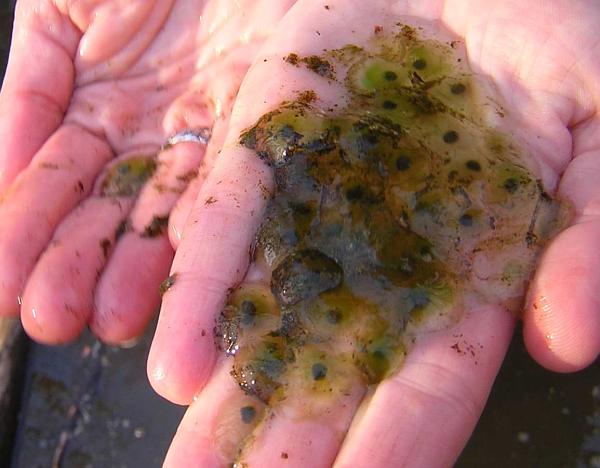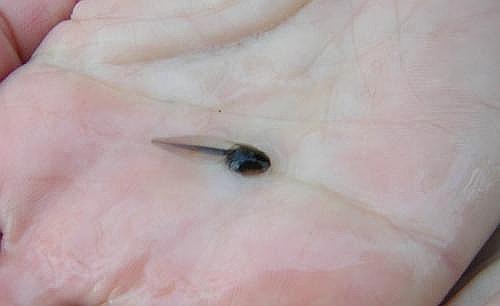That’s Not a Puddle, It’s a Vernal Pool
By Ed Murtagh
Published in the August 2004 Takoma Park Newsletter
Walk through the woods around Sligo Creek in springtime and you’re likely to encounter a vernal pool – and you’ll probably walk by without giving it a second thought. If you look at it at all, you may think it’s a deep puddle or a marshy spot.
But it is more: vernal pools (vernal means spring) play a key but little understood role in our ecosystems. A vernal pool is a small seasonal body of water, sort of a temporary wetland. In our area, vernal pools typically form in depressions during the winter and spring and disappear by summer. They are usually fed by stormwater runoff or ground water and contain no fish. Vernal pools can be found in many locations such as woodlands, floodplains, and meadows.
Small vernal pool in the upper Sligo Creek Park woodlands.

Vernal pools are important because they provide a unique habitat for many species of amphibians, invertebrates and turtles. They typically dry up in the summer, so fish cannot live in these bodies of water. Without fish feeding on them, many species can breed safely in these pools. Some species are called “obligates”, which means they depend on the vernal pools for at least part of their life. In the Sligo Creek watershed, wood frogs and spotted salamanders are examples of obligate vernal pool species.
In Sligo Creek Park, even though the creek is biologically impaired, our vernal pools are frequently full of tadpoles, amphibian eggs, and invertebrates. The following photos were taken April 15, 2004.
Photo of algae covered amphibian egg mass (perhaps wood frogs) found in the small vernal pool shown above.

Photo of tadpole found in the small vernal pool shown above. The vernal pool was full of tadpoles.

But these valuable, little understood bodies of water are vulnerable. Like wetlands, vernal pools are being threatened by development. Also, like swamps and bogs, vernal pools are viewed by many people as nuisances, areas that need to be “improved” and the depressions are frequently filled in or leveled out. Even if the vernal pools themselves are not disturbed, removing nearby trees or developing upland areas will impact vernal pools.
Even though vernal pools are important links to ecological health, there is a lot that scientists still do not understand about them. The Maryland-National Capital Park & Planning Commission and the Montgomery County Department of Environmental Protection (DEP) have been mapping the vernal pools in Montgomery County as part of the Countywide Stream Protection Strategy. DEP and M-NCPPC are developing a Biological Monitoring Database. The database will help us better understand vernal pools and their importance in the ecosystem. The condition of the vernal pools can be one of the indicators of the health of the entire ecosystem.
A new book on vernal pools is expected to be published next year by McDonald and Woodward Publishing.
See www.mwpubco.com/VernalPools.htm. Also, Tina Schneider of Montgomery County MNCPPC is working with EPA and Patuxtent Wildlife Refuge to develop the “Mid-Atlantic Guide to Conserving Vernal Pools and Other Seasonal Wetlands.” This publication is expected to be available later in 2004.
So remember: that’s no puddle – that’s a valuable ecological habitat! Vernal pools can be found in many natural landscapes, not just in officially designated parks. Please educate your neighbors and protect the vernal pools in our neighborhoods.
Ed Murtagh is an engineer with the U.S. Department of Agriculture and Chair of the Friends of Sligo Creek Stormwater Committee.


